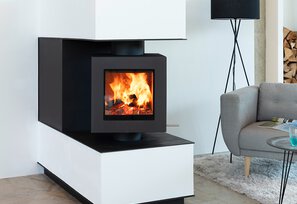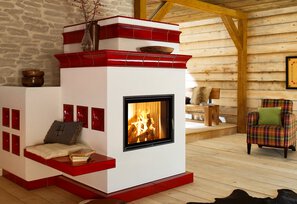A water-bearing wood stove can do more
A water-bearing wood stove has two great advantages: Firstly, a lot of CO2 can be saved by heating with wood fuel and secondly, heating costs can be significantly reduced.
What should you know about a water-bearing wood stove and how does it work?
Can you retrofit any wood stove, what connection does it need and are water-bearing systems subsidised?
We answer all these questions for you in this blog post.

What is a water-bearing wood stove?
Optically, a water-bearing wood-burning stove can hardly be distinguished from a non-water-bearing stove, because the main technology is hidden behind the stove casing: wood is also burnt in a water-bearing system and the resulting heat energy is released into the room. However, not completely. Part of the heat is collected in a buffer tank and fed into the central heating system.
Depending on the requirements, this can be used to heat radiators, floors or a wall panel heating system. A wood stove with a water pocket ensures that the heat generated in the stove can also be used in other rooms of the house. And it is the perfect support for a heating system - especially in the transitional period, when one or two fires a day are sufficient for the heating system and the oil or gas boiler does not even have to start. In times of emergency, the entire heat requirement could even be provided by a water-bearing fireplace or tiled stove.

How does a water-bearing wood stove work?
The combustion chamber of a water-bearing wood stove is double-walled. The space in between has a heat transfer medium in the form of a water pocket, for the passage of the heating water. For heating the water in the water pocket, the excess heat of the flue gases is used, which would otherwise simply escape unused via the chimney. The water heated in the water pockets reaches the central heating system via a buffer tank and thus relieves the entire system. If you want to heat not only the heating water, but also the domestic water in the house, a hygiene storage tank with an integrated heat exchanger is installed instead of the buffer tank.
Two types of output
When it comes to the output of a water-bearing wood stove, a distinction is made between output on the heating side (also water side) and output on the room side (also air side). The output on the heating side benefits the central heating system and the output on the room side benefits the room where the stove is installed. Both characteristic values depend on how the water-bearing fireplace or stove is built and designed. They are stated in the manufacturer's documentation. Both rated heat outputs must be optimum, otherwise the heating system cannot be operated efficiently.
Fireplace or tiled stove?
Whether a fireplace or tiled stove should be water-bearing depends on personal taste. Generally speaking, a water-bearing fireplace is a good choice if you want large viewing glass faces with a lot of fire atmosphere. If the typical pleasant radiant heat of a tiled stove is more important, a water-bearing tiled stove is ideal. Once the decision on a fireplace or a tiled stove has been made, the next step is to select the appropriate heating insert. Here the heat requirement of the building and the size of the installation room are the decisive criteria. BRUNNER offers a wide range of water-bearing heating inserts, first and foremost the HKD series.
Is a water-bearing wood stove eligible for subsidies?
This is particularly interesting with regard to government subsidies . These are not available for water-bearing stoves that are operated with logs, but they are available for water-bearing pellet stoves. The Federal Office of Economics and Export Control (BAFA) and KfW provide subsidies for pellet stoves with water pockets with a rated heat power of five kilowatts or more (thermal use). Eligible are both water-bearing pellet stoves and their installation as well as the associated costs for conversion measures.

Water-bearing wood stove: How does the connection work?
If you want to connect a water-bearing wood stove to a heating system you should definitely ask a specialist, because the measures are extensive, and the retrofitting of a buffer tank and regulation of the heating control belong in the hands of experts. It is generally advisable to involve a chimney sweep right from the start when planning any fireplace - even a water-bearing wood stove. He has to inspect the stove anyway, he can point out solutions, possibilities and legal requirements in advance. If a water-bearing wood stove is used not only to heat domestic hot water, but also as a central heating system, the restrictions of the Federal Immission Control Act are much stricter, especially with regard to exhaust gas values and the exact adjustment of the stove output to the installation site. This must also be particularly checked because water-bearing wood stoves are significantly heavier than traditional ones.
It is recommended to work with a specialist and also with the chimney sweep right from the start. This is the only way to find the perfect system for your individual needs and also to make the best use of the funding opportunities.
Heat pumps-Stove heating
For houses with a heat pump, the combination with a water-bearing wood stove system is an ideal relief. Because when it gets very cold outside, the heat pump needs significantly more electricity and works less efficiently. This is where a water-bearing wood stove can step in. The interaction of the different heat generators is controlled by a heating controller. There are water-bearing heaters that work not only with logs but also as pellet stoves
System solution
BRUNNER offers with its heating centre (BHZ) a special system solution for such hybrid heating systems. Here, intelligent heat management brings heat generators and heat consumers into ideal interaction and also guarantees convenient operation. And in the event of a power failure, an emergency power supply ensures the continued operation of all necessary heating pumps and the control system.
Can a water-bearing stove be operated without water?
The answer is short and simple: no

Conclusion
Even though the water-bearing tiled stove does not differ much visually from a non-water-bearing tiled stove, it is a good relief for the central heating, as the heat is not only given off to the room, but is also fed into the heating system.
The optimal combination in interaction with a heat pump makes you independent of oil and gas.












